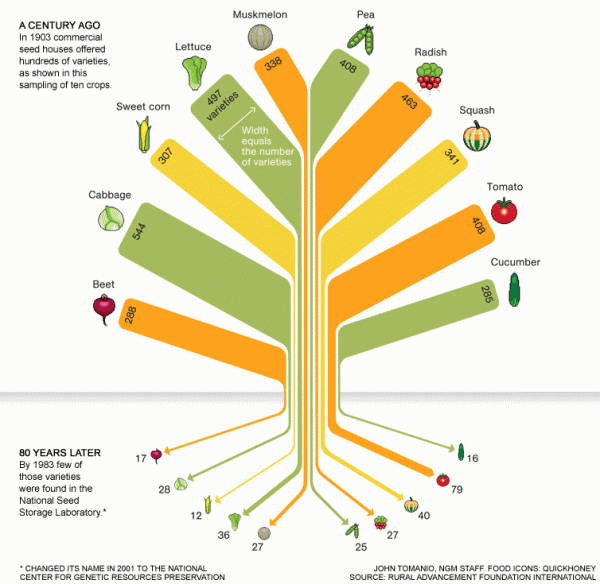Thanks to National Geographic for this for this graphic showing the decrease in vegetable varieties over the past century. The text from the image online reads, “a study conducted in 1983 by the Rural Advancement Foundation International gave a clue to the scope of the problem. It compared USDA listings of seed varieties sold by commercial U.S. seed houses in 1903 with those in the U.S. National Seed Storage Laboratory in 1983. The survey, which included 66 crops, found that about 93 percent of the varieties had gone extinct.”
 If you have been reading my recent posts about seeds and seed saving, this may not be a surprise to you. Nevertheless, you may ask yourself, why does this matter? Why is this important to me? Who cares if there are 17 varieties of beets instead of 288? Well, the first thought that comes to my mind, when I think about agricultural diversity, is cows (no surprise!). The dwindling of livestock breeds (including cows) is a poignant example of the issues with this loss of diversity. You likely know that modern cattle have been bred specifically for high milk production on a largely grain-fed diet. High milk production sounds nice, but at what cost? Important traits such as good bone structure, strong feed, high feed efficiency, fertility, reproductive ease, ability to thrive on grass, strong immune systems, udder health, and milk quality (just to name a few) have largely been bred OUT of the modern high production dairy cows. The result is that most dairy cows in this country are unhealthy, have very short lives, are infertile, and produce milk that is much lower in protein and butterfat than their ancestors. Many small dairy farms like Cricket Creek are trying to breed for the qualities and traits that make cows healthy and give high quality milk as paramount importance to milk quantity. Think about this in terms of produce, because the same principles apply. Most crops (vegetables grains, fruits) have been bred for yield at the expense of pest and disease resistance, hardiness in variable weather conditions, and nutritional value. As was recently reminded to me at a discussion of cow genetics, yes are are in the business of cows, and in the business of farming, but we are first and foremost in the business of producing food for people! That food has to be of the highest quality of we ourselves want to maximize our own health and reach our own genetic potential. National Geographic also has an outstanding photo gallery (18 images) of small scale farmers around the world working to preserve varieties and breeds. There are also photo galleries for Heirloom Produce, Rare Chicken Breeds, and Rare Cattle Breeds. I was proud to see the Randall Cattle as one of the breeds listed. Randall Cattle are a breed indigenous to Vermont; there is a very small herd in this country and most of them are right here in this region. Farmers I used to work for in Chatham, NY have a small herd andCynthia Creech of new Lebanon, NY has many more (she has been raising and breeding them for 20 years). Check out the Rare Cattle Images for a few other great breeds that are worth preserving!
If you have been reading my recent posts about seeds and seed saving, this may not be a surprise to you. Nevertheless, you may ask yourself, why does this matter? Why is this important to me? Who cares if there are 17 varieties of beets instead of 288? Well, the first thought that comes to my mind, when I think about agricultural diversity, is cows (no surprise!). The dwindling of livestock breeds (including cows) is a poignant example of the issues with this loss of diversity. You likely know that modern cattle have been bred specifically for high milk production on a largely grain-fed diet. High milk production sounds nice, but at what cost? Important traits such as good bone structure, strong feed, high feed efficiency, fertility, reproductive ease, ability to thrive on grass, strong immune systems, udder health, and milk quality (just to name a few) have largely been bred OUT of the modern high production dairy cows. The result is that most dairy cows in this country are unhealthy, have very short lives, are infertile, and produce milk that is much lower in protein and butterfat than their ancestors. Many small dairy farms like Cricket Creek are trying to breed for the qualities and traits that make cows healthy and give high quality milk as paramount importance to milk quantity. Think about this in terms of produce, because the same principles apply. Most crops (vegetables grains, fruits) have been bred for yield at the expense of pest and disease resistance, hardiness in variable weather conditions, and nutritional value. As was recently reminded to me at a discussion of cow genetics, yes are are in the business of cows, and in the business of farming, but we are first and foremost in the business of producing food for people! That food has to be of the highest quality of we ourselves want to maximize our own health and reach our own genetic potential. National Geographic also has an outstanding photo gallery (18 images) of small scale farmers around the world working to preserve varieties and breeds. There are also photo galleries for Heirloom Produce, Rare Chicken Breeds, and Rare Cattle Breeds. I was proud to see the Randall Cattle as one of the breeds listed. Randall Cattle are a breed indigenous to Vermont; there is a very small herd in this country and most of them are right here in this region. Farmers I used to work for in Chatham, NY have a small herd andCynthia Creech of new Lebanon, NY has many more (she has been raising and breeding them for 20 years). Check out the Rare Cattle Images for a few other great breeds that are worth preserving!